| April 11, 2020 |
SUPPLEMENT
|
No. 12
|
Notes on the Energy Sector
Inter-Imperialist and Inter-Cartel
Contention Over Control of the Energy Sector
  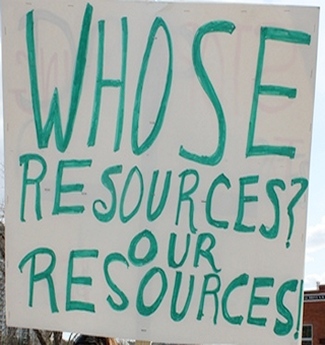
• Contention
over Russian Pipelines to Europe
• U.S.
Imperialism
Strives for Global Hegemony
• Control over the
Canadian Energy Sector
• Questions
on
People's Minds Regarding an Economy and Sector
They Do Not Control
• The
Necessity for Change in the Energy Sector
• U.S.
Hydraulic Fracturing Disrupts Global Oil and Gas
Markets
For Your Information
• The
LNG Canada Project
• Some
Examples of Cancelled
Pipelines and
Energy Projects in Canada
Inter-Imperialist and Inter-Cartel
Contention over Control of the Energy Sector

The overriding issue for Canadians concerning
the energy sector is "Who Controls and Who
Decides?" To assert rational scientific planning
and social responsibility over the production and
distribution of carbon and other energy resources,
the people must wrest control of the sector away
from the global cartels.
Contention among the imperialists in the energy
sector has become increasingly severe especially
since the fracking boom in oil and natural gas
production in the United States. The coup in
Ukraine and the subsequent anti-Russian positions
of the coup government form the backdrop for
attacks against Russian oil and gas exports to
Europe. The U.S. with its now oversupply of
natural gas compared with its internal demand, and
with a similar situation developing with oil but
less desire to export it, has launched a concerted
campaign to displace Russian energy in Europe with
natural gas exported from the U.S. as LNG.
U.S. Energy Oligarchs Strive for Global
Hegemony
With increased production from hydraulic
fracturing, the U.S. energy cartels are now
positioned to export some oil and lots of natural
gas as LNG with Europe as a main target.
Consequent to the rapid increase in domestic
supply, the United States has had a massive shift
in LNG terminal planning and construction starting
in 2010-2011. Many brand-new LNG import-designed
terminals are planning, or have begun, to add
liquefaction facilities and intend to operate
instead as export terminals.
In 2019, many regasification plants have been
converted to liquefaction trains (facilities) i.e.
Sabine pass and others. Seven liquefaction plants
in the U.S. have been built or are under
construction. On November 21, 2019, U.S.
regulators approved permits for three new
liquefied natural gas export terminals in the Rio
Grande Valley in Texas. The Federal Energy
Regulatory Commission approved permits for Rio
Grande LNG, Annova LNG and Texas LNG at the Port
of Brownsville.
Standing in the way of increased U.S. exports of
LNG to Europe is the availability of much cheaper
Russian gas arriving through pipelines. The amount
of Russian gas available to Europe is poised to
greatly increase with the completion of two new
pipelines: Nord Stream 2 and Turkstream.
The U.S. is violently opposed to both pipelines.
It put in place punishing sanctions against all
participants in Russia's Nord Stream 2 expansion
bringing it to a halt. Nord Stream 2 will triple
its current capacity. It includes the world's
longest undersea pipeline linking Russia to
Germany via the Baltic Sea so as to avoid going
through the Ukraine. The U.S. has also imposed
sanctions against any company participating in
Turkstream, a gas pipeline running from Russia to
Turkey, where it can be transferred to existing
pipelines into central Europe. Both projects are
near completion but stalled because of U.S.
opposition and sanctions.
The inter-imperialist and inter-cartel contention
over energy resources and markets arises from the
control of the economy and politics by the
financial oligarchy. This control blocks the
people from asserting their control on the energy
sector and taking it in a new pro-social direction
to humanize the social and natural environment and
avoid war.
Note
Of note especially for Canadians is that the
Dutch-British energy cartel Royal Dutch Shell is a
major investor in Nord Stream 2. The Shell energy
cartel is also the lead investor in LNG Canada,
which is building a gas pipeline across northern
BC to Kitimat on the coast. A liquefaction plant
is being constructed in Kitimat to convert the gas
to LNG for export to Asia.

The rapid development of energy demand in China
and south Korea in recent decades and the
continuing high demand in Japan has become a
source of competition for existing and emerging
energy producers. Russia with new pipelines into
China has established itself as a large supplier
of oil and gas in competition with Saudi Arabia
and other west Asian and African producers and
emerging LNG exporters in the United States.
The obstacle for Russian energy commodities to
reach greater markets in south Korea and Japan is
the U.S. military occupation of both Japan and
south Korea and blockade of the Democratic
People's Republic of Korea.
Russia and many oligarchs in Japan and south
Korea would like to see both oil and gas pipelines
come down through China or Russia directly into
the DPRK and continue through south Korea and
eventually underwater to Honshu in Japan. They
also want rail lines in the Korean Peninsula to
connect with Chinese routes to the west via the
New Silk Road, the Belt and Road Initiative and
with a possible tunnel to Japan.
With U.S. energy production now greater than U.S.
demand, the issue for a faction of the U.S.
imperialists has become one of opening up energy
markets in Asia and raising or at least
stabilizing the price of oil and gas. When the
U.S. was a large importer of oil and gas it sought
to gain control of foreign energy suppliers and
keep the prices low. The U.S. was the main
opposition to OPEC and any attempt to restrict the
supply of oil and gas in the international market
to stabilize prices at least at their prices of
production.
For the U.S. a conundrum has developed from its
fracking bonanza. The sudden quantity of oil and
gas has meant downward pressure on prices. To deal
with the problem, U.S. imperialism has unleashed
new attacks on other producers to suppress oil and
gas production and seize their markets.
 In an unprecedented
frenzy the U.S. has unleashed sanctions and
boycotts against oil and gas producers and
invasion and war. Until recently before the U.S.
hydraulic fracturing allowed the U.S. to become
mostly self-sufficient in oil, Venezuela was a
major supplier to the U.S. Through sanctions and
sabotage, the U.S. imperialists have destroyed
much of Venezuela's oil production and markets.
Iran's oil production and economy are effectively
stymied by U.S. sanctions while invasion and war
have destroyed considerable energy production in
Libya and Syria. The U.S. imperialists have
pressured European companies and governments to
oppose Russian oil and gas projects through
sanctions such as those against the construction
of the Nord Stream 2 and Turkstream pipelines. In an unprecedented
frenzy the U.S. has unleashed sanctions and
boycotts against oil and gas producers and
invasion and war. Until recently before the U.S.
hydraulic fracturing allowed the U.S. to become
mostly self-sufficient in oil, Venezuela was a
major supplier to the U.S. Through sanctions and
sabotage, the U.S. imperialists have destroyed
much of Venezuela's oil production and markets.
Iran's oil production and economy are effectively
stymied by U.S. sanctions while invasion and war
have destroyed considerable energy production in
Libya and Syria. The U.S. imperialists have
pressured European companies and governments to
oppose Russian oil and gas projects through
sanctions such as those against the construction
of the Nord Stream 2 and Turkstream pipelines.
In contrast, Japan, both south and north Korea and China are
keen on having increased oil and gas production,
lower prices and a wider number of suppliers.
Japan and the Korean Peninsula do not have
substantial proven oil and gas reserves and China
is only beginning to explore and develop its
energy resources, and is currently producing 3.9
million bbl per day, somewhat less than Canadian
production of 4.6 million bbl per day but well
below the 15 million bbl per day the U.S.
produces.
Many in the ruling elite in Japan would welcome a
resolution of the isolation of the DPRK because in
their view that would open the possibility of
Russian gas and oil being piped down to Japan
through the Korean Peninsula and then underwater
to Honshu, Japan. As well, they want to see rail
lines and highways up the entire Korean Peninsula
to China and Russia and beyond along the New Silk
Road. Even within the U.S. financial oligarchy,
opposition to the Russian energy and other sectors
is not unanimous as some sections are connected to
and profit from that sector and more broadly from
the Russian economy while others welcome lower
energy prices.
 The situation in
east Asia and Europe and throughout the world is
perilous. In Europe the U.S. strives to retain its
dominance through sanctions and military threats.
In east Asia, the U.S. is repositioning its
military to directly confront China and the DPRK,
and any forces in Japan and south Korea that may
desire to break free from its domination. In west
Asia and north and sub-Saharan Africa, the U.S.
and other imperialists are waging open warfare
against the peoples that want to gain control of
their economies and countries. The situation in
east Asia and Europe and throughout the world is
perilous. In Europe the U.S. strives to retain its
dominance through sanctions and military threats.
In east Asia, the U.S. is repositioning its
military to directly confront China and the DPRK,
and any forces in Japan and south Korea that may
desire to break free from its domination. In west
Asia and north and sub-Saharan Africa, the U.S.
and other imperialists are waging open warfare
against the peoples that want to gain control of
their economies and countries.
Canadians have the social responsibility to make Canada
a factor for peace. This requires Canada leaving NATO and NORAD and
breaking all military alliances and agreements with the U.S.
imperialists. On the economic front, Canadians must gain control over
the strategic energy sector not only as an economic measure
beneficial to Canadians and the social and natural environment but in
order to remove Canada's energy sector from global imperialist
contention and to make it a factor for peace not war.”

The Canadian energy sector is completely
under the control of the global financial
oligarchy, which colludes and contends for the
strategic resource both for profit and to power
their economies and militaries.
 Canadians do not
control the energy sector and have no say over its
direction and development. The development or not
of the sector is a direct result of the decisions
of the cartels in control and their collusion and
contention. Canadians do not
control the energy sector and have no say over its
direction and development. The development or not
of the sector is a direct result of the decisions
of the cartels in control and their collusion and
contention.
Oil, natural gas and LNG are exported and
imported through business deals between and among
cartels. They are not state to state trading
relations that the people control, as they do not
control either the private cartels or the state.
The price received or paid for the energy
commodity is a private affair of the cartels and
states involved and the scores of parasites and
speculators that abound within the imperialist
system.
The market price for natural gas is now well
below its price of production, as is the projected
market price that LNG Canada would receive in Asia
at this time. The price of natural gas has fallen
below $2 per MMBTU (one million British Thermal
Units), while LNG has gone down below $4 per MMBTU
on world markets. This is below what is considered
profitable from fracking extraction and LNG
liquefaction. Some find it remarkable that LNG
Canada would proceed with a project when oil,
natural gas and LNG market prices are below their
prices of production. But this may be the point or
at least part of the attraction aside from the
need for the strategic energy resources to power
industries and militaries.
One of the investor/owners of LNG Canada is
Mitsubishi, which controls the LNG import market
in Japan and is also a major user/consumer of LNG
throughout its vast financial/industrial/trading
empire. The cartel wants to sustain its control
over the LNG market and to seize/steal natural gas
from other countries at the lowest price possible.
This forms part of its program to maintain control
over the market in Japan and maintain a constant
supply of energy for the Japanese economy
including its own industries and military. As far
as supporting or opposing other energy projects
around the world it analyzes the situation and
takes a position that favours its private
interests. This is exactly what all cartels do.
This is what cartels in the expanding "green"
renewable energy sector do as well. They finance
NGOs and other groups to do their bidding either
promoting or opposing energy projects.
To have a rational planned energy sector requires
the people's control over the direction of the
economy, which necessarily controls the wholesale
sector and export and import of commodities. This
requires activating the human factor/social
consciousness to take control over economic
affairs so as to see and act on the necessity not
to permit the private interests of the
imperialists to prevail. Their aim for maximum
private profit is very narrow and has no regard
for the social and natural consequences. Similar
to other sectors of the economy a new pro-social
aim and direction is necessary.

What should working people think of the
opposition to or support for pipelines in Canada?
Does the opposition or support come from a
principled position of opposing imperialism and
its anti-social aim of maximum profit and refusal
to recognize the rights of Indigenous peoples and
refusal to deal with human-influenced climate
change, pollution and other environmental
problems? Or is the opposition or support
manipulated on behalf of powerful private
interests of this or that imperialist cartel both
colluding and contending within the energy sector?
 Why is one pipeline
approved and another cancelled? What is the
difference? Can a principled difference be found
and elaborated? For example, the federal
government cancelled the Northern Gateway oil
pipeline from Alberta to the northern coast of BC
yet is frantically trying to build the Trans
Mountain pipeline to Vancouver despite broad
opposition. What is the great difference? Why one
and not the other? They both are scheduled to
carry the same product. Why not cancel both? Why
not approve both? Why cancel an oil pipeline to
the northern BC coast and then force through the
building of a natural gas pipeline by LNG Canada
on much the same route to the same northern port
city of Kitimat? Why is one pipeline
approved and another cancelled? What is the
difference? Can a principled difference be found
and elaborated? For example, the federal
government cancelled the Northern Gateway oil
pipeline from Alberta to the northern coast of BC
yet is frantically trying to build the Trans
Mountain pipeline to Vancouver despite broad
opposition. What is the great difference? Why one
and not the other? They both are scheduled to
carry the same product. Why not cancel both? Why
not approve both? Why cancel an oil pipeline to
the northern BC coast and then force through the
building of a natural gas pipeline by LNG Canada
on much the same route to the same northern port
city of Kitimat?
The people do not control the energy economy or
any sector for that matter. This collusion and
contention over pipelines is essentially
inter-imperialist and inter-cartel contention over
control of the energy sector. Part of this
contention is to displace traditional oil and gas
(and coal) with renewable energy; part is for
control of the sector; and part is for broader
geopolitical and military reasons to weaken the
influence of contending imperialists in various
regions and globally.
The situation reveals that the imperialists must
not be permitted to manipulate the situation to
the advantage of this or that faction of the
financial oligarchy and lead the people astray,
especially the working class. The organized
working class must identify and defeat any and all
attempts to disinform the working people.
Disinformation is a means to keep the people
unorganized and unable to discuss and uphold a
principled position that favours their interests.
This is a problem that must be taken up for
solution. This struggle forms part of the broader
struggle to gain control over the energy sector.
To restate the thesis: The overriding issue for
Canadians concerning the energy sector is "Who
Controls and Who Decides?" To assert rational
scientific planning and social responsibility over
the production and distribution of carbon and
other energy resources, the people must wrest
control of the sector away from the global
cartels.

 The thousands of
orphaned and abandoned drilling sites left behind
without environmental remediation in both Alberta
and BC expose the greed, anarchy and lack of
social responsibility on the part of the energy
companies. The aim for private profit drives them
into risky and irresponsible decisions before,
during and after their operations. When unforeseen
events occur such as a drop in market prices they
fling up their hands in despair and cry, "What can
we do; we have no money to clean up the mess. End
of story." Not "end of story" but end of such a
socially irresponsible control, direction and aim
of the economy. The global cartels currently in
control of the energy sector show with their
irresponsible practice of leaving behind polluted
orphaned and abandoned sites that they are
incapable of addressing the broader environmental
issues arising from their industry. Time for a
change to the new, to humanize the social and
natural environment! The thousands of
orphaned and abandoned drilling sites left behind
without environmental remediation in both Alberta
and BC expose the greed, anarchy and lack of
social responsibility on the part of the energy
companies. The aim for private profit drives them
into risky and irresponsible decisions before,
during and after their operations. When unforeseen
events occur such as a drop in market prices they
fling up their hands in despair and cry, "What can
we do; we have no money to clean up the mess. End
of story." Not "end of story" but end of such a
socially irresponsible control, direction and aim
of the economy. The global cartels currently in
control of the energy sector show with their
irresponsible practice of leaving behind polluted
orphaned and abandoned sites that they are
incapable of addressing the broader environmental
issues arising from their industry. Time for a
change to the new, to humanize the social and
natural environment!

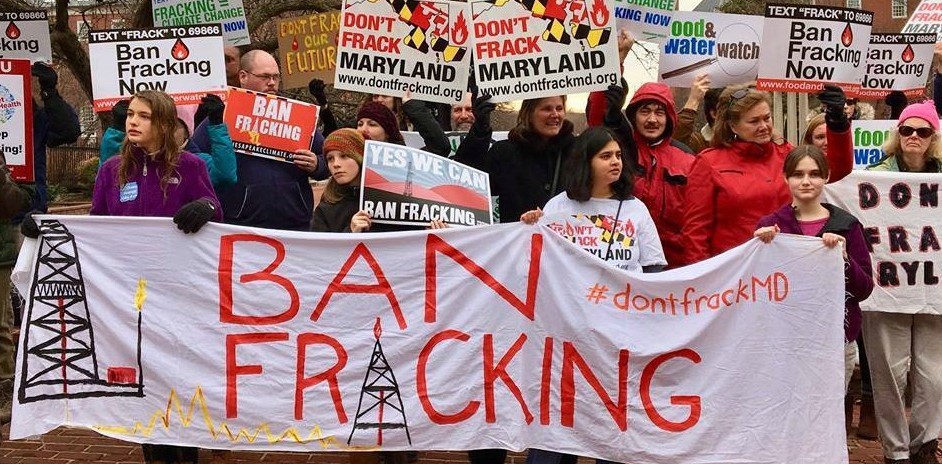
Protest against the dangers of the use of Fracking
have taken place across the U.S. This one in
Maryland in 2017. (Food & Water Watch)
The global oil market price began a steady
decline when U.S. oil production rapidly increased
due to the extensive use of hydraulic fracturing
circa 2011. From 2007 to 2016, annual U.S. oil
production increased 75 percent and beyond to 15
million bbl per day for 2019, while natural gas
production increased 39 percent, due to the
advancements in horizontal drilling and fracking
technology. This caused major oil exporters to the
U.S., in particular Saudi Arabia, to seek other
markets, which led to increasing global
competition for those markets and a price war. It
appears in the present situation that Russia and
Saudi Arabia are seeking an agreement to reduce
global oil supply but the U.S. or at least its
major energy cartels do not want to comply.
In return for any cut of Russian oil production,
Russia probably also wants the U.S. to drop its
opposition to Russia's Nord Stream II and
Turkstream pipelines to Europe and possibly have
U.S. troops leave Syria and return the U.S.
occupied oilfields to the Syrian government.
Deliberately reducing the price of a commodity by
flooding markets with a certain commodity to drive
a competitor out of business is a longstanding
tactic for imperialist cartels. The price of
production of fracked oil is higher than
conventional drilling. The current global market
price below $30 a barrel is driving U.S.
unconventional oil production (hydraulic
fracturing) into crisis. This is what both Russia
and Saudi Arabia want in the short term but Saudi
Arabia cannot appear publicly to support such a
cause because of its dependent status vis-à-vis
U.S. imperialism.
Saudi Arabia is in the toughest bind because of
the Yemen war, the temporary loss of tourism and
pilgrimages to Mecca and its anti-Iran posture. It
has succeeded in finding other oil markets in east
Asia to partly offset the loss of the U.S. energy
market from the growth of U.S. domestic supply but
still the world is awash in oil in particular now
with the COVID-19 crisis. Once the pandemic is
defeated and the demand for energy increases and
with less U.S. supply, with the bankruptcy crisis
having destroyed many small and medium sized U.S.
producers of unconventional oil, the oil price
will rise. At least that is the hope of Russia and
Saudi Arabia and possibly even the big U.S. energy
cartels such as ExxonMobil and Chevron.

For
Your Information
The engineering and overall supervision of the
construction of the LNG Canada project has been
awarded to a joint venture of two large
engineering companies, JGC of Japan and Fluor
Corporation of the U.S.
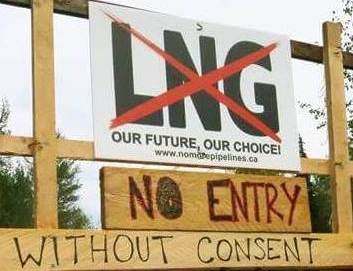 The first phase of
the project is to include a $6.2-billion Coastal
GasLink Pipeline through northern BC, built and
operated by TransCanada. Coastal GasLink is
projected to be a 670-kilometre gas pipeline with
an initial capacity of about 2.1 billion cubic
feet per day (Bcf/day) with the potential for
expansion of up to approximately 5 Bcf/day.
Permits have been issued by the BC government for
the project to proceed in spite of the fact that
the hereditary chiefs of the Wet'suwet'en people,
whose lands the pipeline is to traverse, have not
given their consent and are determined to continue
fighting to stop construction of any pipelines on
their unceded territory. The first phase of
the project is to include a $6.2-billion Coastal
GasLink Pipeline through northern BC, built and
operated by TransCanada. Coastal GasLink is
projected to be a 670-kilometre gas pipeline with
an initial capacity of about 2.1 billion cubic
feet per day (Bcf/day) with the potential for
expansion of up to approximately 5 Bcf/day.
Permits have been issued by the BC government for
the project to proceed in spite of the fact that
the hereditary chiefs of the Wet'suwet'en people,
whose lands the pipeline is to traverse, have not
given their consent and are determined to continue
fighting to stop construction of any pipelines on
their unceded territory.
The pipeline project is backed by a 25-year
transportation service agreement between
TransCanada Corporation and the LNG Canada
partners.
The second phase is the construction of an
$18-billion gas liquefaction and storage plant in
the port of Kitimat, BC, with two liquefaction
trains where the natural gas will be cooled to
reach its liquid state, and then stored to await
transfer to LNG ships for transport to Asian
markets.
A new terminal for LNG carrier ships will be
built at the port of Kitimat, BC connected to the
LNG Canada liquefaction and storage plant.
LNG carrier ships will sail up and down the
Douglas Channel, to and from the port of Kitimat,
to load LNG and sail fully loaded to overseas
destinations, mainly in Asia. Such ships may be
owned and operated by some of the LNG Canada
partners, or by their LNG purchasing clients or
they may be time-chartered from specialized
independent ship owners and operators of such
specialized ships.
Two partners, Royal Dutch Shell and Mitsubishi
have stated that the project will initially export
LNG from two processing units, or trains,
totalling 14 million tonnes per annum (mtpa) of
natural gas, and that, ultimately, the project may
add two more trains for another 14 mtpa.
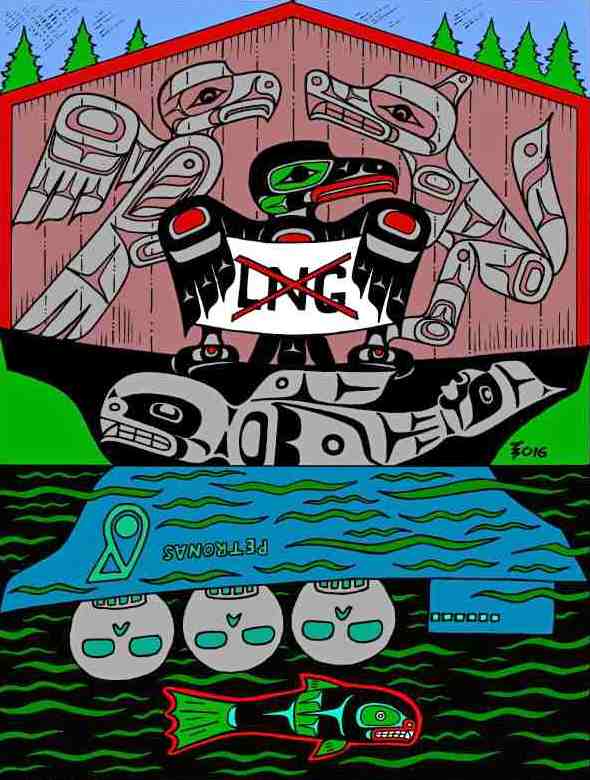 The global LNG
industry, as natural gas in liquefied form, is
being used more and more extensively and directly
to fuel power plants, petrochemical and other
industrial plants and for natural gas distribution
through pipelines to homes and offices, as well as
to fuel various transport modes such as ocean
shipping. The global LNG
industry, as natural gas in liquefied form, is
being used more and more extensively and directly
to fuel power plants, petrochemical and other
industrial plants and for natural gas distribution
through pipelines to homes and offices, as well as
to fuel various transport modes such as ocean
shipping.
When completed, LNG Canada will likely be the
first Canadian terminal to export LNG overseas,
whereas several LNG liquefaction and export
terminals are already operating on the Gulf and
Atlantic coasts of the United States, with others
being planned, including on the U.S. west coast.
Within 10 days of the announcement of the LNG
Canada investment decision in October 2018, two
Japanese gas utilities, Toho Gas and Tokyo Gas,
signed heads of agreement for LNG purchasing
contracts over 15 and 13 years, respectively, with
a subsidiary of one of the LNG Canada partners and
shareholders, the Mitsubishi Group.
LNG Canada is the recipient of tax incentives.
The BC government offered the project a break on
the BC carbon tax, as well as the provincial sales
tax. The total subsidies for the project are
valued at $5.35 billion. The subsidies extend
beyond the natural gas plant itself, to new
transmission lines that are being built by BC
Hydro to service the gas fields where the gas will
be extracted through hydraulic fracturing. These
transmission lines have a cost of $296 million.
The LNG project is slated to be a major recipient
of electricity from the new Site C dam and
hydroelectric project, which will cost more than
$10.7 billion to build and is experiencing cost
overruns. The liquefaction process requires
tremendous energy consumption usually from natural
gas but, if electricity is available from Site C
or independent run of river producers at a lower
cost, it will be used.
Notes
LNG Canada:
The LNG Canada Website says the company will
export Canadian natural gas to Asian markets, and
in the process, put Canada on the global map of
LNG exporting countries and create a world-class
liquefied natural gas (LNG) industry in British
Columbia and Canada.
Joint Venture
Participants:
Royal Dutch Shell Plc. (40 per
cent, lead partner), of the UK and Holland;
PETRONAS (25 per cent), of Malaysia; PetroChina
Co. Ltd. (15 per cent), of China; Mitsubishi Corp.
(15 per cent), of Japan; and Korea Gas Corporation
(5 per cent) of Korea.
Shell: a global leader in LNG
since 1964, helping to pioneer the LNG sector.
Shell operates about 20 per cent of the world's
LNG vessels and has LNG supply projects either in
operation or under construction in ten countries.
PETRONAS: a fully integrated
energy company with extensive experience in LNG.
Through its wholly owned upstream energy company
Progress Energy and its partners, PETRONAS is one
of the largest natural gas reserves owner in
Canada — with the majority of these reserves in
the North Montney natural gas formation in
northeast British Columbia. The price of natural
gas has fallen to
$1.68 per MMBTU, well below the reported price of
production, through fracking in the Montney.
The ownership by PETRONAS of gas reserves in BC
with plans to greatly expand production when
Coastal GasLink begins transporting gas to Kitimat
brings to mind the situation in Alberta where
producers of oil sell it upstream in the U.S. to
themselves at a cheap price for refining and
eventual sale at higher prices. In this situation,
the cartels that control production and
distribution can drive smaller producers out of
business through low prices, declare poverty in
Alberta, abscond without paying corporate taxes or
royalty fees, and instead demand pay-the-rich
schemes including free infrastructure and other
subsidies.
PetroChina Company Limited (PetroChina):
China's largest oil and gas producer and supplier.
PetroChina has launched three LNG import
facilities in China and is increasingly an
investor in global unconventional gas production
(fracking) and LNG export facilities. (PetroChina
was also a big
supporter/investor/committed-buyer-of oil of the
now cancelled Northern Gateway oil pipeline, which
planned to cross BC from Alberta to Kitimat along
a similar route to that of the Coastal GasLink
pipeline.)
Mitsubishi Corporation: Japan's
largest trading cartel with more than 50 per cent
share of LNG imported into Japan. Mitsubishi has
been investing in LNG since 1969 and has an
interest in 11 LNG export projects globally.
Mitsubishi is also a member of the Mitsubishi
keiretsu (Group). The Mitsubishi Group employs
350,000 people and has many business segments or
subsidiaries including finance, banking, energy,
machinery, chemicals, beer and food.
Mitsubishi is one of the original zaibatsu
following the overthrow of the Edo feudal era of
petty production in 1868. The zaibatsu were large
financial houses and trading and manufacturing
companies controlled by powerful business and
merchant families. They immediately made the
transition to become dominant monopolies, as
merged industrial and financial companies after
the overthrow of the Edo feudal government and
international trade and overseas investment of
social wealth became commonplace. The original
seven zaibatsu were Mitsui, Mitsubishi, Sumitomo,
Yasuda, Furukawa, Asano and Kawasaki.
Korea Gas Corporation (KOGAS):
the world's largest LNG importing company and
south Korea's principal LNG provider. KOGAS
operates four LNG import terminals and a
nationwide pipeline network in South Korea, and
another terminal in Mexico.

The following are some examples of cancelled
pipeline and energy projects in Canada, that
illustrate the incoherence and contention in this
sector. In the oil sands alone, there are many in-situ
projects at various stages -- completed but not
brought into production, under construction, on
hold or cancelled.
Energy East Project Cancelled October 5, 2017

The Energy East pipeline owned by TransCanada was
a proposed oil pipeline in Canada. It would have
delivered diluted bitumen from Western Canada to
Eastern Canada, from receipt points in Alberta and
Saskatchewan to refineries and port terminals in
New Brunswick and possibly Quebec. It also would
have served to ship U.S. oil extracted by
hydraulic fracturing from the Bakken Formation
(now transported by rail).
The entire length would have been 4,600
kilometres, with approximately 70 per cent (3,000
kilometres) being existing pipeline that would
have been converted from carrying liquefied
natural gas to carrying diluted bitumen. The
pipeline route would have run from Alberta to New
Brunswick, crossing through Saskatchewan,
Manitoba, Ontario, and Quebec. The project would
have had a capacity of 1.1 million barrels
(~200,000 tonnes) of crude oil per day. Irving Oil
had announced plans to build a new $300-million
terminal at its Canaport facility in Saint John to
export the oil delivered from the pipeline. The
Quebec government was a particularly vociferous
opponent.
Northern Gateway Project Cancelled 2016
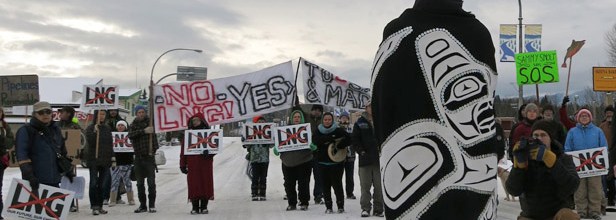
Gitxsan protest against LNG approvals in northern
BC in 2014.
Company: Enbridge (creation of Imperial Oil --
1949)
The Northern Gateway project was first proposed
in 2002. It would have exported diluted bitumen
from Kitimat, BC, to Asian markets, which would
arrive via a pipeline from Alberta. Ship travel
from Kitimat to Asia is two days shorter than from
Vancouver. Enbridge signed a cooperation agreement
with PetroChina in 2005 to ensure the utilization
of pipeline capacity. PetroChina is now a major
investor/participant in LNG Canada.
In 2006, Enbridge delayed the project in favour
of accelerating new lines to the United States. Up
until its outright cancellation by Canada's
federal government in 2016, the project faced
multiple court challenges amid a lengthy
regulatory process, combining to delay its
advancement multiple times. In July of 2016 the
Federal Court of Appeal overturned the previous
approval of Northern Gateway, citing a lack of
meaningful consultations with many Indigenous
communities.
Mackenzie Gas Project Cancelled 2017
Inception: 2000. Companies: ConocoPhillips,
ExxonMobil, Aboriginal Pipeline Group.
Also known as the Mackenzie Valley
Pipeline/Mackenzie River Pipeline, this 1,200 km
project in northern Alberta was initially started
in the mid 1970s but was later scrapped after an
official government inquiry recommended a 10-year
moratorium on pipeline development.
The project was resurrected in 2004 with a new
proposal to transport natural gas to the Beaufort
Sea and abroad with supply coming from pipelines
in northern Alberta. In late 2010 the project was
approved by the National Energy Board only to have
its deadline of 2015 for the start of construction
pass without any construction beginning.
Eagle Spirit Pipeline
The Eagle Spirit Pipeline is a
$16-billion First Nations owned Canadian
pipeline proposed by Indigenous businessman
Calvin Helin, which would ship oil from Northern
Alberta to Prince Rupert, BC following a route
well north of that of Coastal GasLink. The group
filed a request last year with the National
Energy Board for guidance regarding its project
description requirements, an early step in the
regulatory process.
Teck Resources Proposal for Open-Pit Petroleum
Mine
Abandoned 2020

Petitions are delivered to Environment
Minister's office in North Vancouver, January
2020, opposing approval of Tech mines project.
In February 2020, Teck abandoned plans for
Frontier Mine -- a $20 billion open-pit petroleum
mine proposal -- 25 km south of Wood Buffalo
National Park and north of Fort McMurray in
northeast Alberta. In announcing the decision the
CEO hinted that the company was having trouble
finding investors for the project. He wrote in
part, "Global capital markets are changing rapidly
and investors and customers are increasingly
looking for jurisdictions to have a framework in
place that reconciles resource development and
climate change, in order to produce the cleanest
possible products. This does not yet exist here
today and, unfortunately, the growing debate
around this issue has placed Frontier and our
company squarely at the nexus of much broader
issues that need to be resolved. In that context,
it is now evident that there is no constructive
path forward for the project. Questions about the
societal implications of energy development,
climate change and Indigenous rights are
critically important ones for Canada, its
provinces and Indigenous governments to work
through."

(To access articles
individually click on the black headline.)
PDF
PREVIOUS ISSUES
| HOME
Website: www.cpcml.ca
Email: editor@cpcml.ca
|

